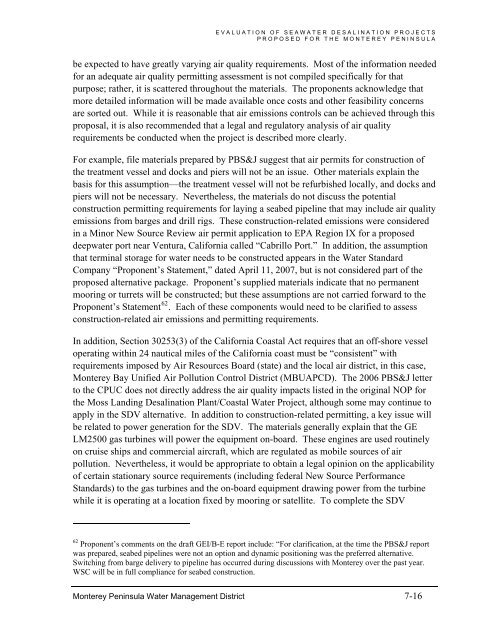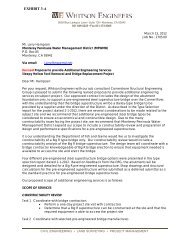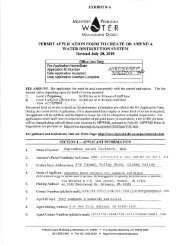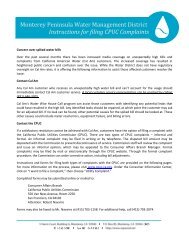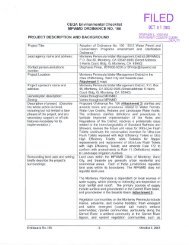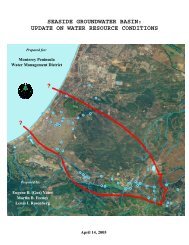FINAL REPORT Evaluation of Seawater Desalination Projects ...
FINAL REPORT Evaluation of Seawater Desalination Projects ...
FINAL REPORT Evaluation of Seawater Desalination Projects ...
Create successful ePaper yourself
Turn your PDF publications into a flip-book with our unique Google optimized e-Paper software.
EVALUATION OF SEAWATER DESALINATION PROJECTS<br />
PROPOSED FOR THE MONTEREY PENINSULA<br />
be expected to have greatly varying air quality requirements. Most <strong>of</strong> the information needed<br />
for an adequate air quality permitting assessment is not compiled specifically for that<br />
purpose; rather, it is scattered throughout the materials. The proponents acknowledge that<br />
more detailed information will be made available once costs and other feasibility concerns<br />
are sorted out. While it is reasonable that air emissions controls can be achieved through this<br />
proposal, it is also recommended that a legal and regulatory analysis <strong>of</strong> air quality<br />
requirements be conducted when the project is described more clearly.<br />
For example, file materials prepared by PBS&J suggest that air permits for construction <strong>of</strong><br />
the treatment vessel and docks and piers will not be an issue. Other materials explain the<br />
basis for this assumption—the treatment vessel will not be refurbished locally, and docks and<br />
piers will not be necessary. Nevertheless, the materials do not discuss the potential<br />
construction permitting requirements for laying a seabed pipeline that may include air quality<br />
emissions from barges and drill rigs. These construction-related emissions were considered<br />
in a Minor New Source Review air permit application to EPA Region IX for a proposed<br />
deepwater port near Ventura, California called “Cabrillo Port.” In addition, the assumption<br />
that terminal storage for water needs to be constructed appears in the Water Standard<br />
Company “Proponent’s Statement,” dated April 11, 2007, but is not considered part <strong>of</strong> the<br />
proposed alternative package. Proponent’s supplied materials indicate that no permanent<br />
mooring or turrets will be constructed; but these assumptions are not carried forward to the<br />
Proponent’s Statement 62 . Each <strong>of</strong> these components would need to be clarified to assess<br />
construction-related air emissions and permitting requirements.<br />
In addition, Section 30253(3) <strong>of</strong> the California Coastal Act requires that an <strong>of</strong>f-shore vessel<br />
operating within 24 nautical miles <strong>of</strong> the California coast must be “consistent” with<br />
requirements imposed by Air Resources Board (state) and the local air district, in this case,<br />
Monterey Bay Unified Air Pollution Control District (MBUAPCD). The 2006 PBS&J letter<br />
to the CPUC does not directly address the air quality impacts listed in the original NOP for<br />
the Moss Landing <strong>Desalination</strong> Plant/Coastal Water Project, although some may continue to<br />
apply in the SDV alternative. In addition to construction-related permitting, a key issue will<br />
be related to power generation for the SDV. The materials generally explain that the GE<br />
LM2500 gas turbines will power the equipment on-board. These engines are used routinely<br />
on cruise ships and commercial aircraft, which are regulated as mobile sources <strong>of</strong> air<br />
pollution. Nevertheless, it would be appropriate to obtain a legal opinion on the applicability<br />
<strong>of</strong> certain stationary source requirements (including federal New Source Performance<br />
Standards) to the gas turbines and the on-board equipment drawing power from the turbine<br />
while it is operating at a location fixed by mooring or satellite. To complete the SDV<br />
62 Proponent’s comments on the draft GEI/B-E report include: “For clarification, at the time the PBS&J report<br />
was prepared, seabed pipelines were not an option and dynamic positioning was the preferred alternative.<br />
Switching from barge delivery to pipeline has occurred during discussions with Monterey over the past year.<br />
WSC will be in full compliance for seabed construction.<br />
Monterey Peninsula Water Management District 7-16


